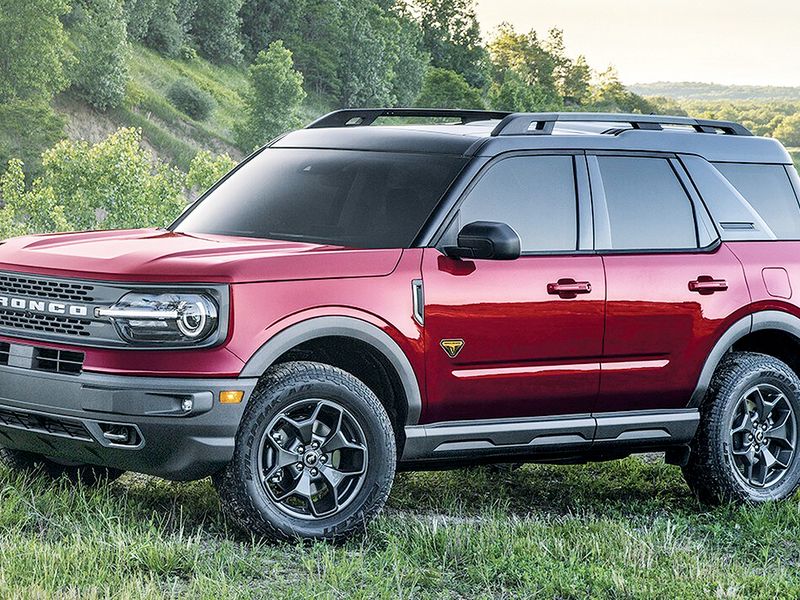
DETROIT — Ford Motor Co. is reestablishing itself in the industry’s largest segment, compact crossovers, after years of declining share with a pair of small utility vehicles aimed at different buyers: the Escape and Bronco Sport.
More than two-thirds of the Bronco Sport’s 60,514 sales so far this year come from buyers new to Ford, the company says. The new offering hasn’t cannibalized sales of the Escape, which rose about 1 percent to more than 85,000 in the first half of 2021 despite the ongoing chip shortage that is crimping production.
Combined, the two small utilities would rank fourth in the segment, behind the Toyota RAV4, Honda CR-V and Nissan Rogue, according to the Automotive News Research & Data Center.
Ford is quickly gaining market share in the segment — up 3 percentage points to 11 percent through the first six months of 2021 — while Toyota and General Motors lose share and Honda’s is flat, according to LMC Automotive data.
“The Bronco Sport has breathed a little bit of life in the segment for them,” Jeff Schuster, president of Americas operations and global vehicle forecasting at LMC, told Automotive News. “Early indicators are this is a two-pronged success.”
It’s a segment in which Ford can’t afford to fail. Compact crossovers account for about 1 in 6 vehicles sold in the U.S. this year and now outsell compact and midsize sedans combined, according to the Automotive News Research & Data Center.
Analysts say the combination of affordability, storage and fuel economy draws buyers from multiple age demographics.
“It’s in the sweet spot for capturing one of the widest spectrums of consumers out there,” said Karl Brauer, an executive analyst with iSeeCars. “If you don’t have a good showing there, you’re missing potential market share and sales.”
The Escape, now No. 7, once was the second-best seller in its segment. In the middle of last decade, it sold more than 300,000 vehicles for four consecutive years.
But its popularity has waned as new entrants emerged. Instead of trying to appeal to a wide swath of buyers, Ford redesigned the Escape in 2019 to be more carlike, leaving room for the Bronco Sport, built on the same platform, to capture a different corner of the market.
“We really saw an opportunity to better compete by offering two nameplates,” said Mark Grueber, Ford’s U.S. consumer marketing manager. “We see some customers looking for more sleek, urban imagery and styling and others looking for more rugged, off-road capability. We think we have great differentiation between the two.”
Brauer says the Bronco Sport benefits from carrying the same badge as the larger Bronco SUV, arguably one of Ford’s most anticipated vehicles in decades.
“Ford knew the Bronco SUV would create a lot of buzz,” he said. “For them to take an existing platform and develop another vehicle with the name attached to it is resulting in both more volume and more profit.”
The Bronco Sport also was helped by getting a bigger head start on the Bronco than intended. Because of coronavirus-related delays dating back to last year, Ford is just now launching the Bronco — which means its smaller sibling has had the attention to itself for half a year instead of only a few months.
“The timing did allow for some more spotlight,” Grueber admitted. “There was a silver lining.”
There could be opportunity for the Escape and Bronco Sport to capture more customers in the coming years, even among Ford buyers.
The automaker reportedly has scrapped plans for the next-generation Edge. That might shift some buyers who don’t want the three-row Explorer’s size or price to the smaller Escape or Bronco Sport, Brauer said.
He expects the Bronco Sport to continue gaining ground on Escape sales and potentially surpass them, given its broad appeal. While there’s still a wide gap for the year, the Bronco Sport was just 516 vehicles behind the Escape in June.
“I think what you’re losing in terms of fuel efficiency or on-road refinement is not enough to counteract what you gain with the name, image, off-road capability and flexibility on the lifestyle side,” Brauer said. “Overall, I think that will pull more buyers going forward than the Escape.”
Grueber declined to discuss volume or sales projections, saying Ford would build both vehicles to meet demand. No matter which vehicle is the better seller as time goes on, he said the strategy already is having the intended effect.
“We’ve started to establish that Ford is going to be a really strong player in the small-utility segment,” Grueber said.
“Our combined share among the two nameplates is going to put us firmly among the leaders.”

